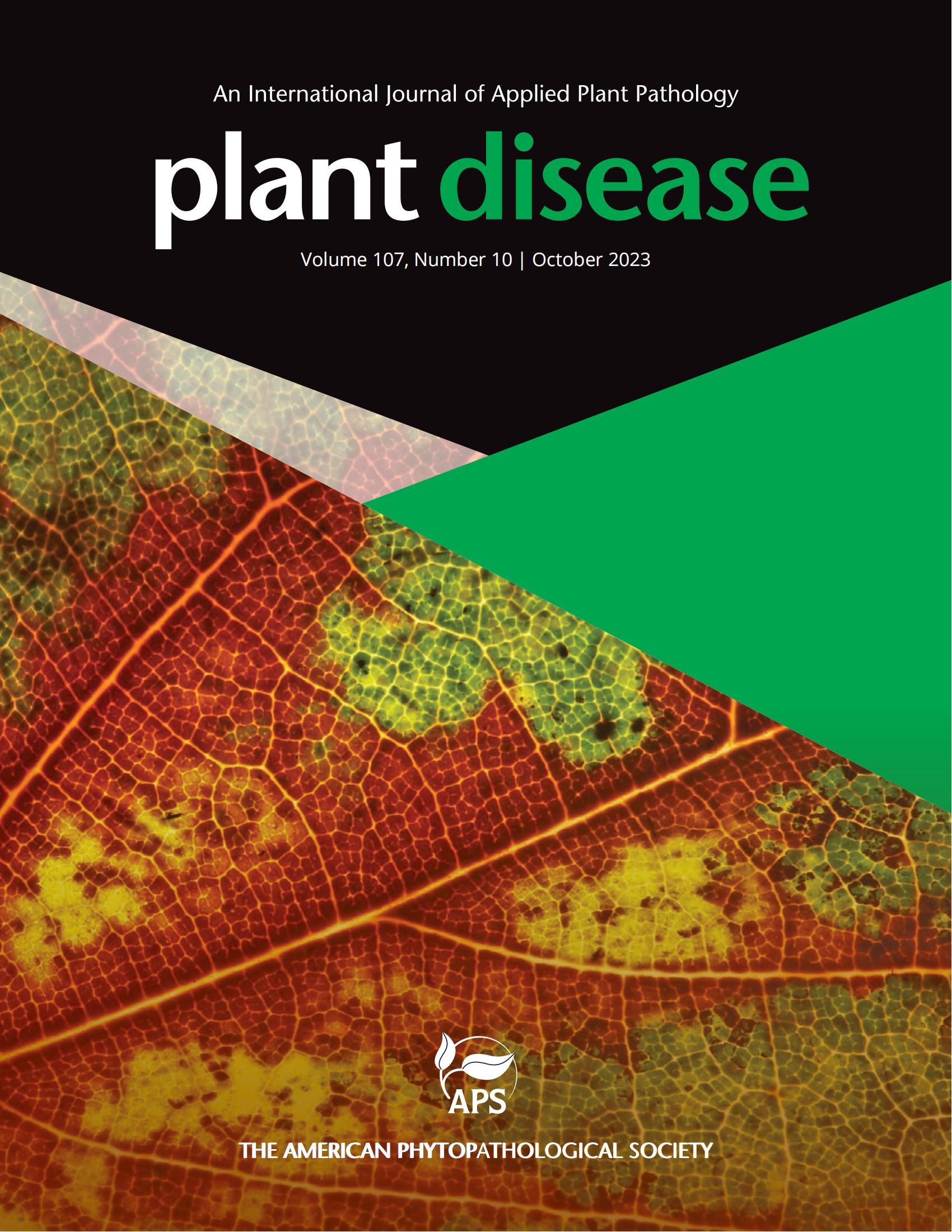台湾白Basella叶斑病报导首例。
摘要
马拉巴尔菠菜(Basella alba)是一种在亚洲广泛种植的叶菜。2023年7月,台湾省苗栗县某有机农场多个网房发生严重叶斑病暴发,发病率100%。最初的症状是小的淡褐色坏死性病变,常伴有红色的晕。随着病情的发展,病变扩大,形成带有同心圆环的棕色斑点和丰富的孢子。采用两种方法分离病原菌:一种是表面灭菌后从小的无孢子病灶中分离组织,另一种是从有孢子病灶中分离单孢子菌。两种分离方法分离得到4株形态相似的菌株BaDpO-1、BaDpO-2、BaDpY-1和BaDpY-2。这些分离株的分生孢子肥大,不分枝或不规则分枝,顶端有一个肿胀的头。头反复二分或三分裂,浅棕色至棕色,宽17-58.1 μm (n=40)。分生细胞终末裂,多裂。分生孢子单生,椭圆形至圆柱形,端部圆形,半透明至黄褐色,2-4分离,尺寸为35.8 ~ 66.2 × 11.9 ~ 18 μm (n=50)。菌核呈卵形至近球形,深褐色至黑色,尺寸为86 ~ 461 × 85 ~ 387 μm (n=50)。PDA上的菌落中心呈黑色,有同心圆的孢子和弥散的黄色色素。利用4株分离菌株的基因组DNA分别用引物V9G/ITS4、gpd1/gpd2和RPB2- 5f2 /fRPB2-7cR扩增内部转录间隔段(ITS)、甘油醛-3-磷酸脱氢酶基因(GAPDH)和RNA聚合酶II第二大亚基基因(RPB2) (Marín-Felix et al., 2019)。该序列已存入GenBank (ITS: PV336058 ~ PV336061;GAPDH: PV345458 ~ PV345461;RPB2: PV345454 ~ PV345457),与基底二疫霉(Dichotomophthora basellae Hern.-Restr)前型菌株CPC 33016同源性100%。, Cheew。& Crous。3个基因序列的系统发育分析表明,4个分离株均与basellae CPC 33016聚类,bootstrap值为100%。在25±3℃条件下,将每个分离物的分生孢子悬浮液(105个/mL)点接种于1月龄白僵菌的4片叶片上进行致病性试验。对照叶片用无菌水处理。4个分离株在接种后1天(dpi)引起扩大的坏死灶。后来,病变上产生的丰富的分生孢子和分生孢子在形态上与原始分离株相匹配。另外,将分离菌株BaDpY-2的分生孢子悬浮液(104个分生孢子/mL)喷洒在3株2月龄植株上,同时对3株对照植株施用无菌水。1 dpi时叶片上出现大量坏死灶,不产孢。病原体成功地从有症状的组织中重新分离出来,并与原始分离物相匹配,实现了科赫的假设。经分子、形态及致病性分析,确定basellae为白叶斑病病原菌,为台湾首次报道。该病最初记录在泰国(Crous等人,2019;Marín-Felix等人,2019),随后在孟加拉国进行了报道(Kader等人,2024)。无论在哪里发生,它都对马拉巴尔菠菜造成了重大损害,强调了早期识别和有效管理策略的重要性。Malabar spinach (Basella alba) is a widely cultivated leafy vegetable in Asia. In July 2023, a severe leaf spot outbreak with 100% incidence occurred in multiple net houses on an organic farm in Miaoli county, Taiwan. Initial symptoms were small pale brown necrotic lesions, often with a reddish halo. As the disease progressed, the lesions enlarged, forming brown spots with concentric rings and abundant sporulation. The pathogen was isolated using two methods: tissue isolation from small non-sporulating lesions after surface-sterilization, and single conidium isolation from sporulating lesions. Four isolates, BaDpO-1, BaDpO-2, BaDpY-1, and BaDpY-2, exhibiting similar morphology were obtained from both isolation techniques. Conidiophores of these isolates were macronematous, unbranched or irregularly branched, with a swollen head at the apex. Heads were repeatedly dichotomously or trichotomously lobed, pale brown to brown, and measured 17-58.1 μm wide (n=40). Conidiogenous cells were terminally lobed and polytretic. Conidia were solitary, ellipsoidal to cylindrical rounded at ends, subhyaline to yellow brown, 2-4-distoseptate, and measured 35.8-66.2 × 11.9-18 μm (n=50). Sclerotia were ovoid to subglobose, dark brown to black, and measured 86-461 × 85-387 μm (n=50). Colonies on PDA displayed a black center with concentric sporulation and diffused yellow pigment. Genomic DNA from the four isolates was used to amplify the internal transcribed spacer (ITS), glyceraldehyde-3-phosphate dehydrogenase gene (GAPDH), and RNA polymerase II second largest subunit gene (RPB2) with the primers V9G/ITS4, gpd1/gpd2, and RPB2-5F2/fRPB2-7cR, respectively (Marín-Felix et al., 2019). The sequences were deposited in GenBank (ITS: PV336058 to PV336061; GAPDH: PV345458 to PV345461; RPB2: PV345454 to PV345457) and showed 100% identity with the ex-type strain CPC 33016 of Dichotomophthora basellae Hern.-Restr., Cheew. & Crous. Phylogenetic analysis inferred from concatenated sequences of the three genes revealed that all four isolates clustered with D. basellae CPC 33016, supported by a 100% bootstrap value. Pathogenicity tests were conducted by point-inoculating conidium suspension (105 conidia/mL) of each isolate to four leaves of 1-month-old B. alba plants without wounding at 25±3°C. Control leaves were treated with sterile water. The four isolates caused expanded necrotic lesions at one day post-inoculation (dpi). Later, abundant conidiophores and conidia produced on lesions were morphologically matched the original isolates. Additionally, a conidium suspension (104 conidia/mL) of isolate BaDpY-2 was sprayed onto three 2-month-old plants, while three control plants received sterile water. Numerous necrotic lesions appeared on leaves without sporulation at one dpi. The pathogens were successfully re-isolated from symptomatic tissues and matched the original isolates, fulfilling Koch's postulates. Based on molecular, morphological, and pathogenicity analyses, D. basellae was confirmed as the causal agent of B. alba leaf spot, marking its first report in Taiwan. This disease was initially recorded in Thailand (Crous et al., 2019; Marín-Felix et al., 2019), with subsequent reports in Bangladesh (Kader et al., 2024). It has caused significant damage to Malabar spinach wherever it occurs, underscoring the importance of early identification and effective management strategies.

 求助内容:
求助内容: 应助结果提醒方式:
应助结果提醒方式:


